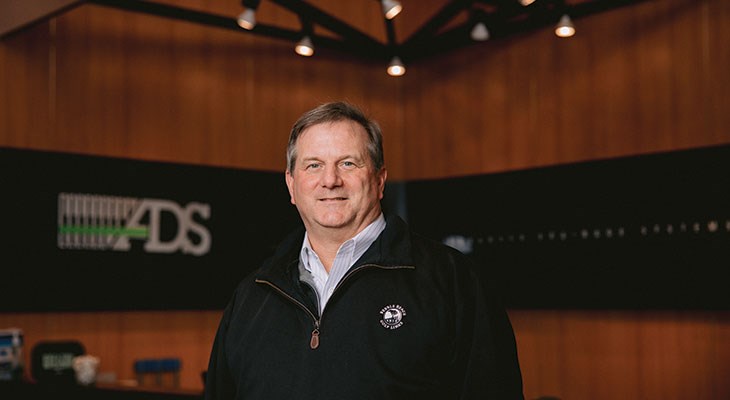Infiltrator Water Technologies had been on Advanced Drainage Systems Inc.’s radar for a while.
“We have been doing business with each other for 15-plus years, buying from each other, selling each other’s products,” says ADS President and CEO Scott Barbour. “We know each other well, and what we do in the marketplace — convert from traditional materials like concrete to plastic products — is very similar.”
In Barbour’s tenure at Hilliard-based ADS, which makes water management products, he continued to develop a relationship with Infiltrator, a provider of on-site septic wastewater treatment. He knew that the Ontario Teachers’ Pension Plan, which bought the business in 2015, would want out at some point.
“When we heard a rumor that Ontario Teachers was considering selling the company or bringing it to market, I worked hard with our Barclays banking partners to get in what I would call pole position, to get into conversation about a potential acquisition,” he says.
Smart Business Dealmakers spoke with Barbour about the $1 billion-plus deal, the largest transaction in the manufacturer’s history.
Working quickly
Negotiations between the two businesses started in earnest around February. ADS stressed the strategic connections, existing strong relationships, and potential upside for employees and the combined companies.
Infiltrator is smaller than ADS — around $300 million in sales to almost $1.4 billion — but slightly more profitable.
Next time, Barbour might take more time upfront with key people to run through challenges to the deal structure and negotiation. “That devil’s advocate, that’s a useful meeting — sometimes a painful meeting, but a useful one,” he says.
The seller wanted a sign-and-close transaction, which isn’t unusual for private equity sellers, Barbour says. However, it was a challenge, and a lot of hard work, for ADS.
Normally, a company signs a letter of intent and then gets the Term Loan B, high-yield bonds and equity financing. Once that’s in place, it closes and pays the seller. In this case, Barbour says ADS closed with a bridge loan from Morgan Stanley and Barclays. The company will use the month of September to line up the bonds, loans and equity financing.
In fact, in one week, ADS announced its Q1 fiscal 2020 financial results a week early, announced and closed the transaction, gave future guidance, and did a shelf registration, which kicks off a lot of financing activities.
“For a company that had not done a transaction of this size before and not done an acquisition in several years, that’s a pretty full plate,” he says. “We got it done and communicated crisply, so we’re quite proud of that.”
The deal closed just in time for the employees to have their last month of summer back and take a sigh of relief, Barbour added.
ADS anticipates potential synergies of $20 million to $25 million with the combined companies.
Both ADS and Infiltrator will be run as before, except for a few key opportunities lead by joint teams, Barbour says. Those are recycling, procurement, new product ideas that could be accelerated, and any cross-selling opportunities between two very different distribution channels.
Seeing the logic
Barbour and his team worked closely with the board during the course of the transaction, which had the added benefit of exposing a broader set of employees to those directors. Their ability to execute the challenging transaction gained them credibility.
However, one of the board’s concerns was the deal size. The transaction required significant engineering of ADS’ capital structure, which the company was able to do because it was in a relatively unlevered position with strong cash flow.
“Frankly, as we were announcing this deal and discussing it with our investors and the sell-side analysts, we thought there might be a lot of surprise or questions about the size of the deal — and that was not the feedback we got,” he says.
The comments were mostly positive, with investors and analysts seeing the industrial logic of the deal, even if they were surprised that such an attractive company — in terms of growth, profitability, industry position, and conversion and recycling characteristics — was available.
“So many times, you find an acquisition and one-third of the people are like, ‘Why are you doing that?’ and that was not the case at all here,” Barbour says.
Investors’ big questions dealt with whether Infiltrator’s high-margins were sustainable and how a highly vectored residential company would look in a downturn.
Barbour feels Infiltrator’s greater than 30 percent EBITDA margins are sustainable because it has a history of innovating new, lower-cost products. The company also uses recycled content and good manufacturing practices.
“They’ve done this for 20 years through different cycles and environments,” Barbour says.
While ADS will have a little more exposure to residential markets with the combined company, ADS is closely tied to non-residential construction, he says. Plus, about 27 percent of Infiltrator’s sales are repair and replace, which tend to be less cyclical.
“When is the next residential downturn and how deep it will be?” he asks. “I don’t know. Our order rates and Infiltrator’s order rates are pretty good right now.
“We see the market steady through the end of this calendar year, and I think it’ll be steady in the next year,” Barbour says, adding that in an election year the economy tends to go well.
“We see a nice runway here, and our job is to take advantage of that runway while the markets are good. After that, if it goes down, well, the markets don’t go up forever and then we’ll adjust our plans and our activities to make sure we can hold our profitability, continue to gain market share.”




